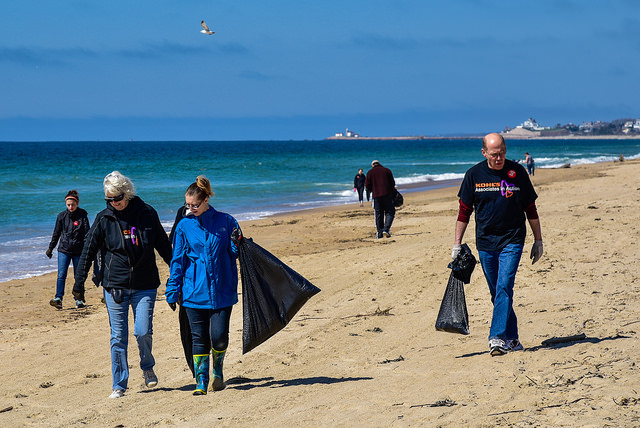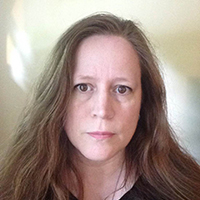I volunteer for Clean Ocean Action, an ocean advocacy team based in New Jersey.
We live here and we care about the waters off the coast of New Jersey and New York. It’s personal, it’s our beach.
We blow up people’s email boxes about fracking off the coast—we raise awareness about water pollution.
Did you know that the fertilizer you use could end up polluting some lake or pond or ocean nearby?
Did you know that outside lighting can affect baby sea turtles and their ability to go toward the water after they hatch?
Endangered animals are not toys or pets—don’t touch the turtles or the eggs.
Clean Ocean Action conducts Beach Sweeps twice a year in April and October, up and down the Jersey Shore.
“We use data collected about what we find to inform people and hopefully change their behavior. We are also trying to get corporations involved to reduce packaging and waste by showing them how their own products are being found in the cleanups.
The goal of the Beach Sweeps is to reduce and eliminate sources of litter.
The Beach Sweeps events are more than people picking-up trash from beaches. This program builds community support for solutions, as well as raises awareness about the negative impacts of litter on wildlife and the ocean. Citizens learn about the types and quantities of debris found along the coast and the shorelines of rivers, lakes and streams.
Most importantly, the data collected during the Beach Sweeps turns a one-day event into a legacy of information to combat litter and other sources of pollution by identifying and monitoring trends. The information helps find solutions to keep beaches clean and healthy for citizens and marine life. Indeed, the data has been used to help create federal, state, and local programs and laws to reduce litter in the environment.
Finally, the data from the COA Fall Beach Sweeps is submitted to the Ocean Conservancy in Washington, D.C. as part of its international database on marine debris and worldwide campaign against ocean pollution.” ~ Clean Ocean Action
Data reports are available on the Clean Ocean Action website, but there’s nothing like seeing it in person.
We send an email blast about a town hall meeting and drive some traffic there, because what we do matters.
Maybe all someone needs is a little nudge in the right direction.
Sometimes it is a Cub Scout troop looking for a volunteer experience for a badge.
This Cub Scout troop ranges from eight to 11-year-olds. I love when parents get kids involved early with volunteer projects, and getting up on a Saturday morning before the fast-food restaurants stop serving breakfast builds character.
Each scout is paired with an adult and briefed on how this works. There is a large white card with an extensive list of things that one could find during the cleanup. Shotgun shells, items of clothing and tampon applicators.
Participants make a tally mark for each item found, we emphasize that while collecting garbage is important, collecting data is too. The data helps us push for changes so there is less of the garbage. The kids understand this and transform into little scribes, recording what we are finding and placing into either the trash bag or the clear recycle bag.
45 cigarette butts found in one hour.
150 tiny plastic drink straws.
One scout brought his little sister and she found a pair of cargo shorts and ran over to me, “Do we recycle these?” “I think not, but you definitely found the most interesting thing today.” I shoved them in our trash bag and continued to scour the sand for cigarette butts. I find these particularly offensive, the world is not our ashtray. According to the Ocean Conservancy, cigarette butt litter accounts for one in every five items collected during cleanups.
Trash cans dot the boardwalk but somehow they are not being used.
How did I maximize this opportunity to teach young children about volunteering and the environment?
1) I briefed the boys and their parents ahead of time.
I briefed the parents about what we might find and safety precautions and I got the boys excited with some questions about what they might find when they are cleaning up. None of these kids predicted the scores of cigarette filters we would find on the sands. I also explained the big picture for this project, that Clean Ocean Action uses the data that we collect to show people what changes need to happen to reduce the amount of trash we pick up.
2) I paired each child with an adult, to keep them on task and to be an encouraging cheerleader through the process.
The adult and the child took turns being scribe or collector and we got them excited to keep filling the bags. It’s hard to collect garbage for two or three hours but the competitive boys collected quite a bit of garbage and data. We also spent a minute looking up and down the boardwalk, noting all the trash cans available but unused.
3) We debriefed afterward to explain what happens next and to let them feel the experience.
When we finished, we took pocket phone pictures of our data cards and the trash we collected. We spent a little time reflecting on the positive emotions that come from doing such a thing for themselves and others.
“People don’t recognize the hidden power of everyday experiences,” says Hanson. “We’re surrounded by opportunities—10 seconds here or 20 seconds there—to just register useful experiences and learn from them.” ~ Rick Hanson
I didn’t want to waste this opportunity to show the Cub Scouts how to be with what they just experienced.
We also talked about how other people think that what they did is important, the Beach Sweep has corporate sponsors.
Overall, the encounter was positive. The parents felt a sense of pride that they had this opportunity to share with their boys, the boys were shocked that we were responsible for removing such a large amount of trash. The data we collected will help Clean Ocean Action with their efforts at stopping litter at its origin.
And these boys hopefully learned and felt the value of what they did, that their two or three hours were meaningful in some way. I’m sure they got better at spotting trash cans.
~
Author: Josette Myers
Editor: Ashleigh Hitchcock
Photo: Save the Bay









Read 0 comments and reply